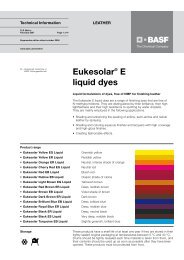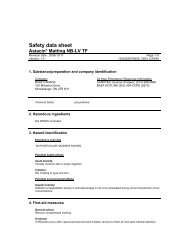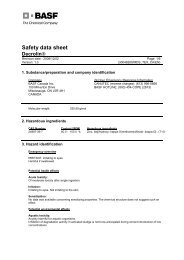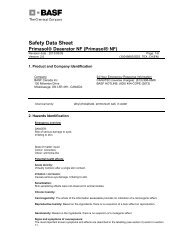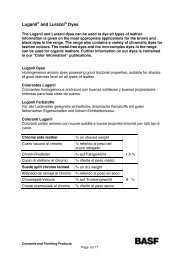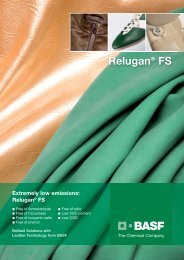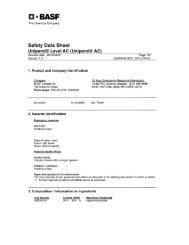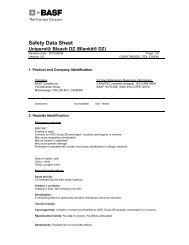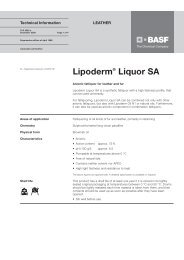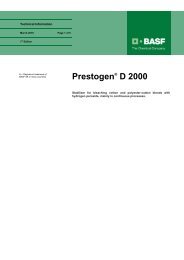Hydrosulfite Types - BASF
Hydrosulfite Types - BASF
Hydrosulfite Types - BASF
Create successful ePaper yourself
Turn your PDF publications into a flip-book with our unique Google optimized e-Paper software.
Technical Information<br />
<strong>Hydrosulfite</strong> <strong>Types</strong><br />
TI/T 7015 e<br />
October 1997 (RB)<br />
Supersedes TI/T 1489 dated January 1993<br />
® = Registered trademark of<br />
<strong>BASF</strong> Aktiengesellschaft<br />
<strong>Hydrosulfite</strong> Conc. <strong>BASF</strong><br />
<strong>Hydrosulfite</strong> Conc. <strong>BASF</strong> N<br />
<strong>Hydrosulfite</strong> F Conc. <strong>BASF</strong><br />
<strong>Hydrosulfite</strong> FE Conc. <strong>BASF</strong><br />
Reducing agents for the textile industry<br />
Textile and Leather Dyes and Chemicals
Nature<br />
Physical form<br />
Storage stability<br />
Anhydrous sodium dithionite (Na 2<br />
S 2<br />
O 4<br />
), technical grade, stabilized<br />
Powder<br />
<strong>Hydrosulfite</strong> Conc. <strong>BASF</strong> and <strong>Hydrosulfite</strong> Conc. <strong>BASF</strong> N have a shelf life<br />
of up to 24 months.<br />
<strong>Hydrosulfite</strong> F Conc. <strong>BASF</strong> and <strong>Hydrosulfite</strong> FE Conc. <strong>BASF</strong> have a shelf<br />
life of up to 12 months.<br />
Storage<br />
All <strong>Hydrosulfite</strong> types must be stored in closed containers, and the<br />
containers must be protected from moisture.<br />
If the products are not stored under suitable conditions or if moist scoops<br />
are used to take product out of the containers, or if moisture enters a containers,<br />
the product decomposes. The moist product becomes lumpy and<br />
it develops heat and gases (with the odour of sulphur dioxide), resulting<br />
finally in spontaneous combustion, particularly in the presence of atmospheric<br />
oxygen (cf. “Action in the case of spontaneous combustion” on<br />
page 7).<br />
Handling of partially<br />
decomposed product<br />
Impurities<br />
<strong>Hydrosulfite</strong> that has become lumpy must immediately be removed from<br />
the drum by passing it through a coarse sieve, after which the lumps must<br />
be dissolved in water. Only the residual, powdery product is fit for use.<br />
<strong>BASF</strong>’s <strong>Hydrosulfite</strong> types are practically free of heavy metals (below the<br />
level of detectability).<br />
2
Properties<br />
Physical and chemical data<br />
Appearance<br />
Solubility<br />
White powder<br />
Readily soluble in dilute alkalis: approx. 250 g/l at 20 °C. The solution is<br />
water-white without any turbidity.<br />
,,,<br />
500<br />
,,,<br />
400<br />
,,,<br />
300<br />
,,,<br />
dissolved<br />
undissolved<br />
,,,<br />
200<br />
,,,<br />
100<br />
,,,<br />
,,,<br />
0<br />
0 100 200 300 400<br />
<strong>Hydrosulfite</strong> Conc. <strong>BASF</strong> (g/l)<br />
Caustic soda 38 °Bé (ml/l)<br />
Fig. 1<br />
Solubility of <strong>Hydrosulfite</strong> Conc. <strong>BASF</strong> in the presence of alkali<br />
Stability of the solutions<br />
<strong>Hydrosulfite</strong> solutions have a strong reducing action and bind atmospheric<br />
oxygen. 1 m 3 of air binds roughly 1.7 kg of hydrosulfite. <strong>Hydrosulfite</strong> reacts<br />
with atmospheric oxygen many times more rapidly than its own relatively<br />
slow decomposition. In working with dissolved hydrosulfite, contact with<br />
air must therefore be avoided as far as possible. In acid media, hydrosulfite<br />
decomposes to form mainly sulphur dioxide, sulphur and other<br />
sulphur-containing compounds. Alkalis have a stabilizing action on<br />
solutions of hydrosulfite, particularly when the solution is exposed to air.<br />
3
<strong>Hydrosulfite</strong> Conc. <strong>BASF</strong> (g/l)<br />
30<br />
20<br />
exclusion of air<br />
presence of air<br />
without alkali<br />
10<br />
50 ml/l NaOH 38 °Bé<br />
30 g/l <strong>Hydrosulfite</strong> Conc. <strong>BASF</strong><br />
25 °C<br />
0<br />
0 2 4 6 8 10<br />
h<br />
Fig. 2<br />
Stability of hydrosulfite solutions under various conditions<br />
pH value<br />
<strong>Hydrosulfite</strong> Conc. <strong>BASF</strong> and<br />
(50 g/l in water) <strong>Hydrosulfite</strong> Conc. <strong>BASF</strong> N 7– 9<br />
<strong>Hydrosulfite</strong> F Conc. <strong>BASF</strong> and<br />
<strong>Hydrosulfite</strong> FE Conc. <strong>BASF</strong> 6 – 7<br />
For pH measurements, oxygen must be completely excluded. The<br />
measurement must be carried out under nitrogen and with air-free water.<br />
Bulk density<br />
The <strong>Hydrosulfite</strong> types vary in their bulk density. This must be taken into<br />
consideration in volumetric metering.<br />
<strong>Hydrosulfite</strong> Conc. <strong>BASF</strong> 1300 –1400 g/dm 3<br />
<strong>Hydrosulfite</strong> Conc. <strong>BASF</strong> N 1150 –1250 g/dm 3<br />
<strong>Hydrosulfite</strong> F Conc. <strong>BASF</strong> and<br />
<strong>Hydrosulfite</strong> FE Conc. <strong>BASF</strong> 750 – 900 g/dm 3<br />
Action<br />
Preparation of<br />
hydrosulfite solutions<br />
In the textile industry, hydrosulfite is used mainly as a reducing agent for<br />
vat dyes and for the reductive clearing of dyeings on polyester. It is also<br />
suitable for stripping dyeings and for cleaning dye becks, dyeing<br />
machines, etc.<br />
<strong>Hydrosulfite</strong> solutions are best prepared immediately before use. The alkali<br />
should be added to the bath first, after which the hydrosulfite powder is<br />
strewed into the bath with stirring.<br />
The process can be carried out very economically by using a dissolving<br />
station and obtaining the product in containers.<br />
This method has the following advantages:<br />
– no dusting<br />
– less risk of fire<br />
– lower product wastage<br />
4
In this method, a solution is prepared containing approx. 130 g/l of hydrosulfite<br />
together with the requisite amount of alkali (260 ml/l of NaOH<br />
38 °Bé). The solution is then piped to the department where it is required.<br />
This concentrated reducing agent solution only has to be diluted and is<br />
then ready for use.<br />
Applications<br />
As a reducing agent for vat dyes<br />
The main field of application for hydrosulfite is the reduction of vat dyes in<br />
order to convert them into a water-soluble form with affinity for the fibre.<br />
The vat dyes are either reduced direct in the dyebath or, as in pigmentation<br />
dyeing processes, pigment padding processes, and two-phase printing,<br />
they are first applied to the textile material in an insoluble form and<br />
then subsequently developed with hydrosulfite and caustic soda.<br />
The reducing action of hydrosulfite depends on the temperature and the<br />
pH. Under the conditions of an IN vat, the redox potential is approx.<br />
–1000 mV. This potential is sufficient to convert all commercially available<br />
vat dyes into the water-soluble sodium leuco compound, because all of<br />
these dyes are reduced in the potential range of approx. – 650 to – 950 mV.<br />
The dye must remain completely vatted throughout the whole dyeing process.<br />
However, since the hydrosulfite is continuously decomposed by the<br />
action of air, with consumption of alkali, the vat must always contain an<br />
excess of hydrosulfite and caustic soda.<br />
The presence of this excess must be ensured throughout the entire<br />
dyeing process. The simplest method is to check the alkalinity with<br />
phenolphthalein paper, and the reducing action with Vat Yellow paper.<br />
The amounts of hydrosulfite necessary for the various dyeing processes<br />
are indicated in our pattern card for Indanthren ® dyes, MK/T 266.<br />
For the reductive clearing of dyeings<br />
Dyeings and prints produced with disperse dyes on polyester fibres,<br />
triacetate fibres, and various fibre blends are cleared with alkaline<br />
hydrosulfite solutions in order to obtain the best possible standard of<br />
fastness.<br />
4– 8 ml/l caustic soda 38 °Bé<br />
2– 3 g/l <strong>Hydrosulfite</strong> Conc. <strong>BASF</strong><br />
0.5 g/l Uniperol ® EL<br />
20 min at 70 – 80 °C<br />
Vat dyes Liquor ratio 10 :1 to 30 :1<br />
For stripping or partial stripping of dyeings and prints<br />
<strong>Hydrosulfite</strong> is suitable for the reductive stripping of dyeings and prints<br />
produced with vat, direct, and reactive dyes on cellulosic fibres.<br />
In package systems<br />
and winches<br />
Set the bath at 75 – 80 °C with<br />
0.5 g/l Dekol ® S<br />
2– 3 g/l Setamol ® WS<br />
10– 15.5 ml/l caustic soda 38 °Bé<br />
5 g/l <strong>Hydrosulfite</strong> Conc. <strong>BASF</strong><br />
1 g/l glucose<br />
(for vat dyes that are sensitive to over-reduction)<br />
2– 3 ml/l Albigen ® A<br />
and treat the textile material for 3 min at 75 – 80 °C (with indirect steam).<br />
Ensure that a fully vatted state is maintained.<br />
5
Rinse with<br />
1 ml/l caustic soda 38 °Bé<br />
1 g/l <strong>Hydrosulfite</strong> Conc. <strong>BASF</strong><br />
1 g/l Setamol WS<br />
for 5 min at room temperature, and then rinse with cold water with<br />
overflow. If necessary, then oxidize at 55 °C with<br />
1– 2 ml/l hydrogen peroxide 35%.<br />
On the jig<br />
Liquor ratio 5 :1 for pale shades and up to 10 :1 for dark shades<br />
Set the bath at 75 – 80 °C with<br />
1 g/l Dekol S<br />
3– 5 g/l Setamol WS<br />
20 ml/l caustic soda 38 °Bé<br />
10 g/l <strong>Hydrosulfite</strong> Conc. <strong>BASF</strong><br />
1 g/l glucose<br />
(for dyes that are sensitive to over-reduction)<br />
2– 3 g/l Albigen A<br />
and treat the dyeing over 4 ends, but never longer than for 40 min at<br />
75 – 80 °C (with indirect steam). Ensure that a fully vatted state is<br />
maintained.<br />
As the dye-Albigen A addition compounds have low solubility (with formation<br />
of tarry deposits under certain conditions), short liquor ratios and long<br />
treating times must be avoided. If necessary, the stripping process should<br />
be repeated. The goods are then rinsed with cold water with overflow, and<br />
than oxidized with 1– 2 ml/l of hydrogen peroxide 35% at 55 °C.<br />
Direct dyes 1.5 g/l soda ash<br />
2 g/l <strong>Hydrosulfite</strong> Conc. <strong>BASF</strong><br />
2 g/l Albigen A<br />
30 – 60 min at 50 °C<br />
followed by intensive rinsing.<br />
Reactive dyes 15 ml/l caustic soda 38 °Bé<br />
5 ml/l <strong>Hydrosulfite</strong> Conc. <strong>BASF</strong><br />
2 ml/l Albigen A<br />
30 – 60 min at 60 – 80 °C<br />
followed by intensive rinsing.<br />
For cleaning dyeing machines and equipment<br />
Alkaline solutions of hydrosulfite are used to remove dye residues from<br />
dyeing machines, mixing vessels, rollers, etc. The cleaning action of the<br />
solutions can be promoted by adding Albigen A or Uniperol AC.<br />
Safety<br />
When using this product, the information and advice given in our Safety<br />
Data Sheet should be observed. Due attention should also be given to<br />
the precautions necessary for handling chemicals.<br />
Contact of the products with oxidizing agents (hydrogen peroxide, sodium<br />
chlorite, and sodium hypochlorite) must be avoided under all conditions.<br />
<strong>Hydrosulfite</strong> must always be kept at a safe distance away from these<br />
agents.<br />
Action in the case of spontaneous combustion<br />
See our Technical Information Bulletin TI/T 311 e of July 1997:<br />
Measures to be taken in the case of fire or accidents in transportation.<br />
6
Note<br />
The information submitted in this publication is based on our current<br />
knowledge and experience. In view of the many factors that may affect<br />
processing and application, these data do not relieve processors of the<br />
responsibility of carrying out their own tests and experiments; neither do<br />
they imply any legally binding assurance of certain properties or of suitability<br />
for a specific purpose. It is the responsibility of those to whom we<br />
supply our products to ensure that any proprietary rights and existing laws<br />
and legislation are observed.<br />
7
Printed in Germany<br />
Regional Marketing<br />
Asia<br />
Regional Marketing<br />
North America, Canada<br />
and Mexico<br />
Regional Marketing<br />
South America<br />
Regional Marketing<br />
Europe, Africa and West Asia<br />
<strong>BASF</strong> Textile and Leather<br />
Dyes and Chemicals Pte. Ltd.<br />
7 Temasek Boulevard<br />
#35-01 Suntec Tower One<br />
Singapore 038987<br />
Tel.: (65) 432 34 00<br />
Fax.: (65) 432 34 34<br />
<strong>BASF</strong> Corporation<br />
Textile /Leather Colors and<br />
Chemicals<br />
4330 Chesapeake Drive<br />
Charlotte, NC 28216, USA<br />
Tel.: (1) 704 398 43 80<br />
Fax.: (1) 704 398 42 50<br />
<strong>BASF</strong> S.A.<br />
Química Têxtil<br />
Estrada Samuel Aizemberg 1707<br />
09851-550 São Bernardo do Campo/<br />
São Paulo - Brazil<br />
Tel.: (55) 11 751 22 33<br />
Fax.: (55) 11 751 69 89<br />
<strong>BASF</strong> Aktiengesellschaft<br />
Textil- und Lederchemie<br />
67056 Ludwigshafen/Germany<br />
Tel.: (49) 621 60 41366<br />
Tel.: (49) 621 60-0<br />
Fax.: (49) 621 60 78452<br />
Telex: 46499-0 bas d<br />
Textile and Leather Dyes and Chemicals



